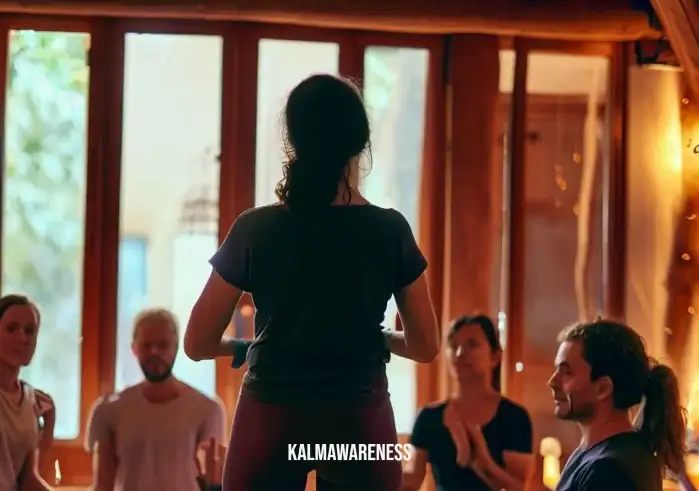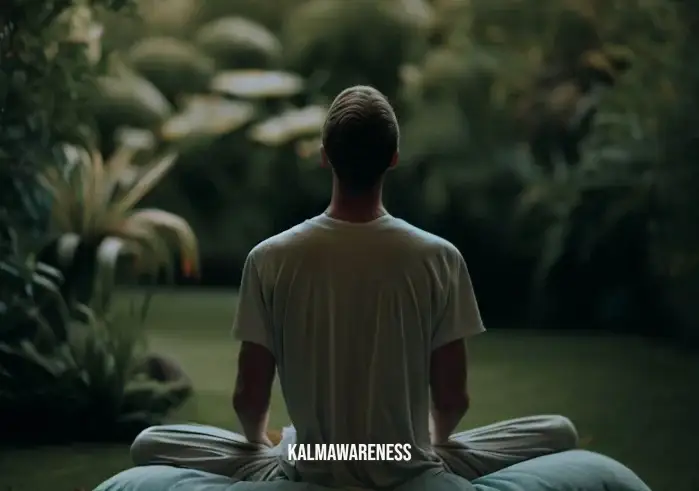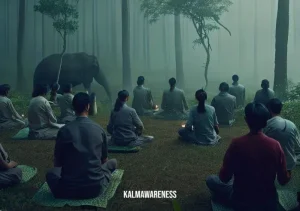Exploring the Squat Pose
In this article, we embark on an enlightening journey into the world of yoga poses, with our focus set on the captivating and transformative Squat Pose. Get ready to delve into the essence of this grounding and empowering posture as we explore its benefits, origins, difficulty level, category, and step-by-step guide.
Yoga Pose Squat Details
| Description | Explanation |
|---|---|
| Pose Name | Squat Pose |
| Original Name | Malasana |
| Difficulty Level | Intermediate |
| Pose Category | Asana |
| Exercise Duration | Beginners: 30 seconds <br> Advanced: 1-2 minutes |
Understanding the Squat Pose
The Squat Pose, also known as Malasana, is a revitalizing yoga posture that finds its roots in ancient yogic traditions. This pose is widely revered for its ability to strengthen the lower body, improve flexibility, and invigorate the mind and soul.
Benefits of the Squat Pose
Embrace the full potential of the Squat Pose as it gracefully bestows an array of advantages upon those who practice it regularly:
- Hip Flexor Stretch: The Squat Pose offers a deep and satisfying stretch to the hip flexors, easing any accumulated tension and enhancing mobility.
- Strengthens Lower Body: Engage your quadriceps, hamstrings, and glutes to cultivate strength and stability in the lower body.
- Digestive Health: By stimulating the digestive organs, this pose aids in promoting healthy digestion and alleviating digestive discomfort.
- Calms the Mind: As you settle into this grounding pose, it calms the mind, reduces stress, and fosters a sense of tranquility.
The Story Behind the Squat Pose
The roots of the Squat Pose can be traced back to ancient yogic texts, where it was practiced by sages and seekers as a means of connecting with the earth’s energy. In its original form, Malasana was used to facilitate meditation and spiritual growth. Today, it remains an integral part of various yoga practices, adapting to modern needs while staying true to its roots.
Exploring the Pose
Step-by-Step Guide to Mastering the Squat Pose:
- Starting Position: Begin by standing tall with your feet slightly wider than hip-width apart. Position your feet at a comfortable angle, pointing slightly outward.
- Bend Your Knees: Gradually bend your knees and lower your body into a squatting position. Keep your heels grounded on the floor.
- Hands Together: Bring your palms together in a prayer position at your chest, gently pressing your elbows against your inner knees.
- Lengthen Your Spine: Elongate your spine and draw your shoulders back, opening your chest and heart center.
- Engage Your Core: Activate your core muscles to stabilize the posture and maintain balance.
- Breathing: Take slow, deep breaths as you hold the pose, allowing yourself to relax and find a sense of peace.
- Release: To release the pose, bring your hands down to the floor and slowly straighten your legs to stand back up.

Unveiling Its Wondrous Benefits
In the captivating journey of exploring the Squat Pose (Malasana), we now venture into the realm of its enchanting benefits, offering insights into the individuals who can embrace this posture and those who might need to approach it with caution. Additionally, we’ll explore the exciting variations of the Squat Pose, catering to practitioners of different experience levels.
Embracing the Gift of the Squat Pose
As you welcome the Squat Pose into your practice, you open the door to a multitude of physical, mental, and emotional benefits that this pose bestows upon you:
Physical Benefits:
- Toned Muscles: By engaging the muscles in the legs, hips, and lower back, the Squat Pose helps tone and strengthen these essential areas.
- Improved Flexibility: Regular practice of Malasana enhances the flexibility of the ankles, knees, and hip joints, allowing for increased range of motion.
- Healthy Spine: The elongated spine in this pose contributes to improved posture and spinal health.
- Enhanced Digestion: The gentle compression on the abdomen stimulates the digestive organs, promoting efficient digestion and detoxification.
- Pelvic Floor Support: Practicing Squat Pose helps in strengthening the pelvic floor muscles, benefiting urinary and reproductive health.
Mental and Emotional Benefits:
- Stress Relief: As you sink into the grounding nature of this pose, it releases tension and calms the mind, providing relief from stress and anxiety.
- Focus and Concentration: The meditative aspect of Malasana encourages enhanced focus and mental clarity.
- Emotional Release: This posture opens the hips, often referred to as the “emotional storage” area, allowing for the release of stored emotions and energy.
Not Recommended for Everyone
While the Squat Pose offers an array of benefits, it might not be suitable for everyone, and certain individuals should approach it with caution or avoid it altogether:
- Knee Injuries: Those with knee injuries or chronic knee pain should practice Malasana under the guidance of a qualified yoga instructor to avoid exacerbating the condition.
- Lower Back Issues: Individuals with lower back problems, especially herniated discs or sciatica, should consult a healthcare professional before attempting this pose.
- Pregnancy: Pregnant individuals should exercise caution while practicing Squat Pose, modifying it as needed to ensure safety for both themselves and the baby.
Variations for All Levels of Experience
One of the many beautiful aspects of yoga is its adaptability to cater to practitioners of diverse experience levels. The Squat Pose offers a range of variations that enable everyone to reap its benefits, regardless of their yoga journey:
1. Supported Squat Pose:
Beginners or those with limited flexibility can use a yoga block or cushion to support their heels in this pose. This variation reduces the intensity of the stretch while still providing the foundational benefits.
2. Garland Pose (Malasana Twist):
For those looking to deepen the experience, the Garland Pose incorporates a twist. This variation stimulates the spine and internal organs while adding an extra challenge to the core.
3. Advanced Crow Pose (Bakasana) Transition:
Experienced practitioners can explore transitioning from Malasana to Crow Pose, a challenging arm balance that requires focus, core strength, and balance.
4. One-Legged Squat Pose:
This advanced variation involves lifting one leg off the floor while maintaining the squat position, offering an intense hip and core workout.

Yoga Pose Squat: Unveiling Its Ancient Wisdom
In the third installment of our captivating journey through the world of yoga poses, we dive into the history and spiritual significance of the revered Squat Pose (Malasana). Delve into the depths of this ancient posture and uncover the profound wisdom it holds, along with valuable tips, common mistakes to avoid, and complementary poses that can enhance your practice.
A Glimpse into the Past: The History of Squat Pose
The Squat Pose finds its origins deeply rooted in the ancient practices of yoga. With its Sanskrit name “Malasana,” this pose has been part of yogic traditions for centuries. In ancient texts, Malasana was considered a natural way of sitting and was used for meditation and contemplation.
Throughout history, the Squat Pose has maintained its significance, not only as a physical posture but also as a symbol of humility, grounding, and connecting with the Earth’s energy. It was practiced by sages and spiritual seekers to foster inner awareness and deepen their spiritual journey.
Embracing the Spiritual Significance
Beyond the physical benefits, the Squat Pose holds profound spiritual significance that resonates with practitioners:
1. Root Chakra Activation: Malasana activates the Muladhara or Root Chakra, symbolizing stability, security, and the feeling of being grounded.
2. Connection to the Earth: As you lower yourself into the squat, you establish a connection with the Earth, embodying a sense of balance and oneness with nature.
3. Releasing and Letting Go: This pose encourages surrender and release, allowing practitioners to let go of physical and emotional tension, purifying the body and mind.
4. Symbol of Transformation: The squatting position symbolizes the process of transformation and growth, embracing change with grace and acceptance.
Tips for a Fulfilling Squat Pose Experience
To make the most of your Squat Pose practice, keep these tips in mind:
- Warm-Up: Prioritize a gentle warm-up for the hips and lower back to ease into the posture smoothly.
- Steady Breathing: Maintain slow and deep breathing throughout the pose to stay centered and focused.
- Heels Support: If your heels don’t comfortably reach the floor, place a rolled-up towel or blanket under them for support.
- Align Your Knees: Ensure your knees track in line with your toes to protect your knee joints during the pose.
- Engage Your Core: Activate your core muscles to provide stability and support during the posture.
Common Mistakes to Avoid
Avoid these common errors to maintain proper alignment and prevent strain:
- Rounding the Back: Avoid rounding your back excessively; aim for an elongated spine.
- Knees Caving In: Be mindful of your knees collapsing inward; keep them in line with your toes.
- Tension in Shoulders: Soften your shoulders and keep them away from your ears to release tension.
Modifications for Injuries and Limited Flexibility
Modifications are essential to accommodate different bodies and individual limitations:
- Using Props: Utilize props like a block under your heels or a cushion beneath your hips to lessen the intensity.
- Elevating the Heels: If your heels don’t reach the floor comfortably, place a folded mat or blanket underneath for support.
- Chair Variation: Those with knee issues can try the Chair Squat Pose, using a sturdy chair for support.
Poses that Complement Squat Pose
Enhance your practice by incorporating poses that beautifully complement the Squat Pose:
- Garland Pose (Malasana Twist): Deepen the stretch with a gentle twist, activating the spine and core.
- Forward Fold (Uttanasana): Pair the Squat Pose with a forward fold to lengthen the spine and stretch the hamstrings.
- Pigeon Pose (Eka Pada Rajakapotasana): Follow up with Pigeon Pose to open the hips and release tension.
Embrace the Wisdom of Malasana
With each breath and mindful movement, the Squat Pose (Malasana) offers a sacred space to connect with your inner self, embracing both the physical and spiritual dimensions of your practice. As you continue your yoga journey, allow the wisdom of this ancient pose to guide you towards greater strength, balance, and inner peace.





